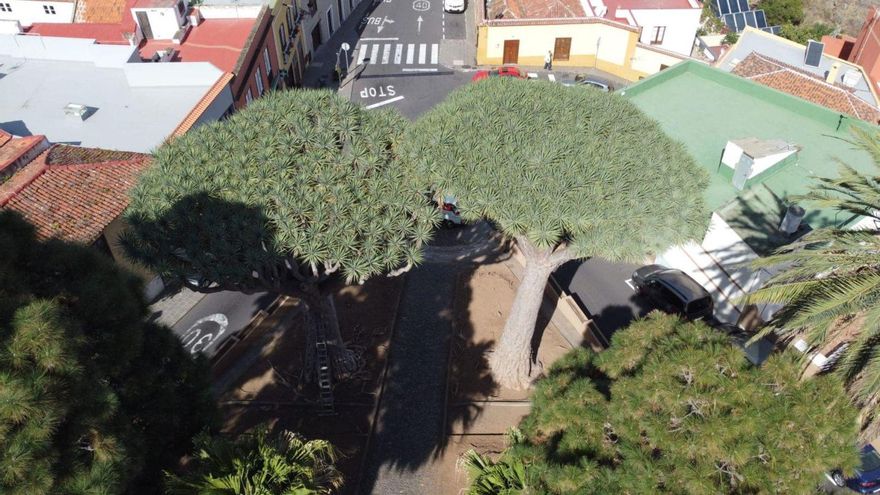
Since the Royal City Council learned of the state of one of the twin dragon trees, through a neighborhood complaint (see exploded view), the City Council immediately contacted the area of Historical Heritage of the Cabildo of Tenerife, as well as the Department of Plant Health of the Government of the Canary Islands and the Canary Institute of Agrarian Research (ICIA), through the management of the Botanical Garden of Acclimatization of La Orotava. In just a few days, specialized personnel from these three entities came to the municipality to directly inspect and assess both the so-called twin dragon trees and the specimen located in the San Francisco cemetery, which has also received new care.
The first measure taken in May was to remove all the vegetation and the irrigation network from the flowerbeds where these dragon trees grow. Subsequently, the quality of the soil and the tops and trunks of both specimens were analyzed. These studies, and direct observation of the cups, made it possible to determine that the origin of the problem was in a cochineal plague that has already been controlled “by washing with potassium soap,” explains González.
“They are completely healthy”
«The two dragon trees are completely healthy, as is the dragon tree in the San Francisco cemetery. We have eliminated the cochineal and it can already be seen with the naked eye that there are more leaves on the branches. The last thing we have done is an aerial observation with a drone. These images have been recorded and will also help us to make a comparison of the state of the glasses in six months. This will allow us to study the evolution of both specimens even better, ”the councilor details.
The local government is very satisfied with the result of the actions carried out: «The dragon trees have reacted very well and we have decided to maintain the treatment and other measures for a while. The gardens of the twin dragon trees will remain in their current state for six more months, to ensure that the lower part of the specimens finishes drying. In principle there will be at least two more sessions of treatment with potassium soap to the leaves to prevent the cochineal from returning.
Thanks to the study of the crowns using cranes, the technicians were able to discover that one of the specimens was affected by the birth of new specimens of dragon trees and other plant species in some cavities of its branches. These “parasites” have been removed and the wounds that the specimen presented on its trunk and branches have been “sealed, thus preventing other plants from growing again.”
The Los Realejos City Council is preparing a small project to be able to intervene in the gardens of this square in 2022 with the aim of covering the roots that have been left out in the open with earth and picón. Technicians from the Cabildo’s Historical Heritage area have already made a visit to analyze this action that plans to build “small walls around the dragon trees.”
A neighborhood complaint in May
On May 14, 2021, the art historian Germán Rodríguez published on the social network Facebook a photograph of the twin dragon trees of Realejo Bajo to denounce the increasing loss of leaves in one of the glasses. He commented that “for a few days the clarity in the glass of one of the dragon trees in the Domínguez Afonso square has been striking. On its side, on the ground, a large number of leaves are visible. The opposite looks bushy and leafy. It is obvious. It should be studied and analyzed by experts, but we cannot lose it. You cannot neglect some specimens that differentiate us as a people. Two days later, another realejero, Rubén Toste, transferred the problem to the local council, through the application of incidents, and on the 17th the visits of technicians and botanical specialists began to determine the cause of his condition. | RS















